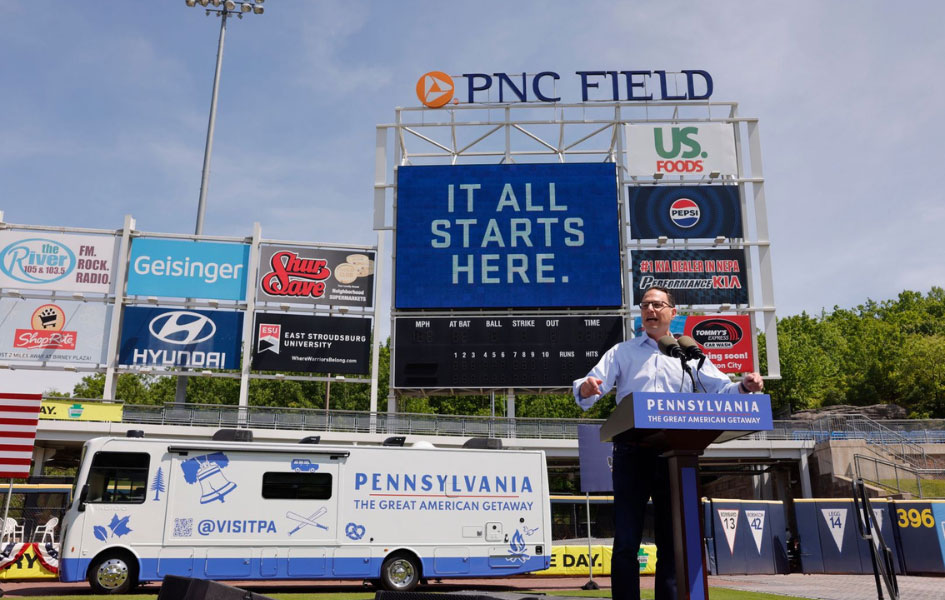
Some Destination Marketing Headlines You May Have Missed
This May, we bring you an exciting array of insights in destination marketing. Discover Pennsylvania’s new tourism brand, “The Great American Getaway,” and how it aims to boost local economies and attract millions of visitors. Explore the transformative impact of destination promotion on community vitality as revealed by Destinations International. Learn strategies for managing visitor expectations to create exceptional travel experiences. Dive into the travel habits of Gen Z and what makes them a significant demographic for the industry. Finally, understand why influencers should be an integral part of your marketing strategy. Continue reading!

Pennsylvania Rebrands as "The Great American Getaway"
Governor Josh Shapiro recently unveiled Pennsylvania’s new state tourism brand, “Pennsylvania: The Great American Getaway,” aimed at enticing millions of potential visitors within a few hours’ drive. This initiative is part of a broader economic development strategy, reflecting the significant role tourism plays in Pennsylvania’s economy. With over $76 billion generated annually and more than 486,000 jobs supported, tourism is a vital economic engine for the state. Governor Shapiro’s administration is backing this effort with an $18 million increase in the tourism and business marketing budget, demonstrating a strong commitment to enhancing the state’s appeal as a premier travel destination.
The campaign positions Pennsylvania as an ideal weekend getaway, leveraging its proximity to major East Coast cities such as New York, Baltimore, and Washington, D.C. The state boasts a diverse range of attractions, including historic sites, outdoor recreation, world-class dining, and vibrant small towns. By promoting these varied experiences, the campaign aims to attract the 72 million people who live within a four-hour drive of the state. This strategic focus on regional visitors is designed to boost local businesses, support communities, and create new opportunities for residents.
The launch of “The Great American Getaway” is accompanied by a robust marketing campaign running from late May through August. This includes high-impact outdoor advertising, multiscreen video, and targeted digital media, all directing traffic to the newly rebranded VisitPA.com. The website offers curated two- and three-day itineraries tailored to different traveler interests, from family adventures to romantic escapes. By enhancing the visibility of Pennsylvania’s unique destinations and experiences, this campaign not only aims to increase visitor numbers but also to foster a deeper appreciation of the state’s cultural and natural heritage.
Read More
Destinations International Releases New Report
Destinations International recently released a groundbreaking study titled “Destination Promotion: A Catalyst for Community Vitality,” highlighting the extensive benefits of destination promotion beyond the tourism industry. This report underscores the transformative power of attracting visitors, which can spur broader economic development, enhance the quality of life for residents, and strengthen the community’s overall identity. As Don Welsh, President & CEO of Destinations International, stated, the study provides data-driven evidence of how destination promotion fundamentally strengthens communities.
The report identifies several key benefits of effective destination promotion. Firstly, it highlights the direct economic impacts, such as increased visitor spending, job creation, and tax revenue generation. This influx of economic activity supports not only the hospitality and leisure sectors but also has a positive ripple effect on other industries, including finance, insurance, and real estate. By driving visitor spending, destination promotion helps local businesses thrive and fosters a more resilient and diverse economy.
Furthermore, the study emphasizes how destination marketing enhances the quality of life for residents. Tourism development often leads to the improvement of local amenities, cultural offerings, and infrastructure, making communities more attractive places to live and work. This enhancement of local amenities also helps in attracting new talent and businesses, contributing to sustained economic growth. Effective destination branding not only draws visitors but also instills a sense of pride among residents, fostering a stronger community identity.
The indispensable role of Destination Organizations (DMOs) in driving these positive outcomes is a key focus of the report. DMOs are pivotal in attracting visitors, promoting local businesses and cultural assets, and advocating for policies that support a thriving tourism economy. The research conducted by Tourism Economics, Longwoods International, Clarity of Place, and MMGY NextFactor provides clear evidence of how DMOs contribute to the broader economic and social fabric of their communities. By leveraging their expertise and resources, DMOs can help destinations realize their full potential as vibrant, dynamic places to visit and live.
This comprehensive report, available for download on Destinations International’s website, is a valuable resource for DMOs and other stakeholders looking to understand and harness the power of destination promotion. It provides actionable insights and data that can guide strategic planning and advocacy efforts, ensuring that destination promotion continues to be a catalyst for community vitality and economic prosperity.
Read More
Managing Visitor Expectations for Destination Success
In today’s travel landscape, managing visitor expectations has become a crucial element for destinations aiming to differentiate themselves and ensure high levels of visitor satisfaction. Travelers are more informed and discerning than ever before, with 72% frequently reading reviews before making decisions on where to stay, eat, or what to do. This article draws insights from several industry experts, emphasizing the importance of communication, transparency, and personalization in setting and exceeding expectations.
Effective communication is the cornerstone of managing visitor expectations. Establishing straightforward and consistent communication channels ensures that travelers are well-informed about what to expect. Shawna Faniel from Alabama Tourism emphasizes the importance of making sure clients understand the scope, timelines, and details of their travel plans. Providing detailed information about packages, additional costs, and necessary preparations, such as weather conditions and local customs, helps travelers feel prepared and enhances their overall experience.
Transparency is another key factor in building trust with visitors. Being candid about what can and cannot be delivered sets realistic expectations and helps avoid disappointment. Marlene Smith from Traverse City Tourism advocates for full transparency, even if it means advising clients against certain attractions or experiences that may not meet their needs. By under promising and overdelivering, destinations can create memorable experiences that exceed visitor expectations, fostering trust and long-term loyalty.
Personalization plays a significant role in enhancing the visitor experience. Tailoring recommendations and services to meet the specific needs and interests of travelers can turn a good trip into a great one. Sandy Haines from Visit Myrtle Beach highlights the importance of knowing the client’s market, whether it’s senior adults, students, or church groups, and offering personalized assistance. Inviting clients for familiarization tours (FAM) can also provide them with firsthand experience, helping them make informed decisions.
Creativity and engagement are essential for exceeding expectations and creating unique, memorable experiences. Jill Shorkey from Go Great Lakes Bay Regional CVB advises staying positive, being adaptable, and thinking outside the box to provide the best possible experience for visitors. Engaging with visitors before, during, and after their trip through pre-arrival emails, real-time support, and follow-up surveys or thank-you notes can significantly enhance the overall experience.
In conclusion, effectively managing visitor expectations is more than just a marketing strategy—it’s the key to creating exceptional travel experiences. By embracing clear communication, transparency, personalization, creativity, and ongoing engagement, destinations can not only meet but surpass expectations, ensuring visitors return and recommend them to others.
Read More
Understanding Gen Z's Travel Habits
Generation Z, those born between 1997 and 2012, is emerging as a significant force in the travel industry. According to this report done in January 2024, 75% of Gen Z travelers in the U.S., U.K., and Germany had taken two or more trips in the previous 12 months. This demographic’s travel habits reveal a distinctive set of preferences and behaviors that are shaping the future of travel.
One notable trend is the high spending on travel among Gen Z travelers, particularly on accommodations. Brands like Generator and Freehand, which cater to the 18-28 age group, reported a 15% increase in revenue in 2023 and a 40% increase in bookings in markets such as Miami, Madrid, and New York. This demographic prioritizes travel over other expenditures, with more than half willing to cut spending on dining out, shopping, and coffee to maintain their travel budgets. This willingness to prioritize travel underscores the importance they place on experiences over material goods.
Flexibility, unique experiences, and accessible destinations are highly valued by Gen Z travelers. Seventy-five percent of them took two or more trips in the past year, reflecting their desire for frequent and varied travel experiences. They prefer experiences over luxury goods, with 79% of Gen Z and millennial respondents in the 2023 Global Travel Trends Report by American Express Travel considering leisure travel a vital part of their budget allocation. Additionally, 84% would choose a dream vacation over acquiring a new luxury item, indicating a strong preference for enriching experiences.
Despite their enthusiasm for travel, only a limited percentage of Gen Z travelers are open to long-haul flights on low-cost carriers. Skift Research found that only 31% of U.S. Gen Z travelers are willing to fly more than six hours on a budget carrier. This highlights their demand for comfort and convenience even when looking for affordable options. TikTok has also emerged as a crucial trip-planning tool for this demographic, with 89% of 18- to 25-year-olds in the U.S., U.K., Canada, and Australia discovering new destinations through the platform.
Sustainability is another critical factor for Gen Z travelers. Many are looking to avoid alcohol on vacations to ensure safety, with 83% considering not drinking alcohol on trips. Furthermore, destinations with strong green credentials are increasingly appealing to them. According to a StudentUniverse survey, half of Gen Z travelers prioritize booking with companies that have robust sustainability practices, and 13% have stopped traveling by plane due to emissions concerns. Skift Research also reported that 29% of Gen Z members are willing to pay over $100 for vacation experiences that are environmentally and socially responsible, with 17% willing to pay whatever is necessary for the most sustainable option.
These travel habits of Gen Z indicate their importance as a demographic for the travel industry, particularly for businesses that can offer unique, flexible, and sustainable travel experiences. Understanding and catering to these preferences will be key to engaging this generation of travelers effectively.
Read More
Influencer Marketing: A Powerful Tool for DMOs
In the digital age, influencer marketing has emerged as a significant force in the travel industry, yet it often evokes mixed reactions among Destination Marketing Organizations (DMOs). Despite the skepticism, the impact of influencers on shaping perceptions and driving travel decisions is undeniable. In this webinar, it is discussed how the influencer marketing industry is projected to reach $15 billion by 2022, with lifestyle and travel being top categories. Understanding how to effectively leverage influencers can provide DMOs with a powerful tool to enhance their marketing efforts.
The accelerated digital adoption due to the pandemic has made influencers an even more prominent tactic for creating awareness and shaping destination brands. Influencers offer a unique ability to connect with audiences on a personal level, sharing authentic experiences that resonate more deeply than traditional advertising. This authenticity can be particularly compelling in the travel industry, where potential visitors seek genuine insights and recommendations. By integrating influencers into their marketing strategies, DMOs can tap into these trusted voices to reach wider and more engaged audiences.
For a successful influencer campaign, DMOs need to move beyond the stereotypes of influencers seeking freebies and focus on building structured, mutually beneficial relationships. This involves selecting the right influencers whose values and audience align with the destination’s brand. Detailed planning and clear communication are essential to set expectations and define goals. Metrics for success should be established upfront, focusing on engagement rates, reach, and conversion metrics rather than just follower counts.
Moreover, DMOs should consider the influencer’s perspective to foster long-term collaborations. Influencers are more likely to produce authentic and engaging content when they feel valued and respected. Offering them immersive experiences that highlight the unique aspects of the destination can result in content that genuinely captures the destination’s appeal. Providing influencers with the freedom to express their creativity can also lead to more authentic and relatable content that resonates with their followers.
Ultimately, influencers should be seen as partners in promoting the destination rather than just marketing tools. By working collaboratively, DMOs can create compelling narratives that enhance the destination’s brand and attract more visitors. As the travel industry continues to evolve, embracing influencer marketing can help DMOs stay relevant and competitive, effectively reaching today’s digitally savvy travelers.
Read More


